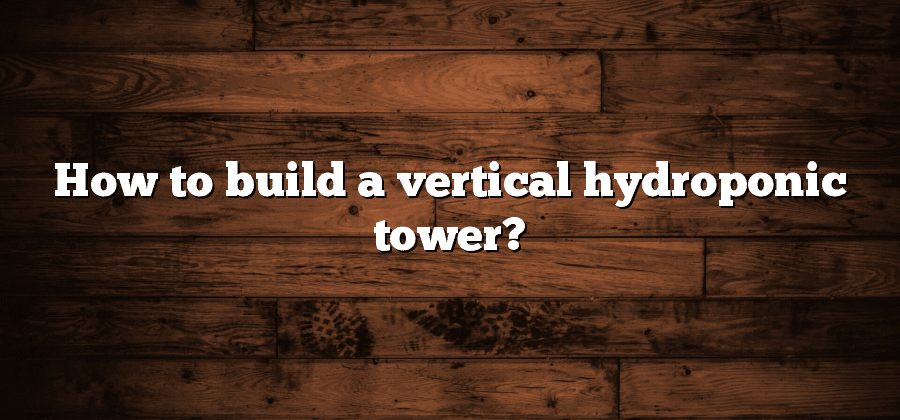Understanding the Basics of Vertical Hydroponic Towers
Vertical hydroponic towers are a cutting-edge solution for growing plants in limited spaces. Unlike traditional horizontal hydroponic systems, these towers utilize vertical space efficiently, making them ideal for urban environments and small gardens. The basic concept behind vertical hydroponic towers is to stack multiple layers of growing trays on top of each other, allowing plants to grow upwards towards the sunlight.
One of the main benefits of vertical hydroponic towers is their ability to maximize harvest yield in a small footprint. By utilizing vertical space, these towers can accommodate a larger number of plants compared to traditional gardening methods. This is especially useful for urban farmers or hobbyists with limited space available. Additionally, vertical hydroponic towers provide better air circulation and sunlight exposure, leading to healthier and more productive crops.
Selecting the Right Materials for Your Hydroponic Tower
When it comes to selecting the right materials for your hydroponic tower, there are several key factors to consider. First and foremost, you want to ensure that the materials you choose are durable and able to withstand the unique demands of a hydroponic system. Since your tower will be constantly exposed to water and nutrient solutions, it is important to select materials that are resistant to corrosion and can endure the moist environment.
Another crucial aspect to keep in mind is selecting materials that are non-toxic and safe for your plants. Remember, in a hydroponic system, the roots of your plants will directly come into contact with the materials used. Therefore, it is essential to avoid using any materials that may potentially release harmful substances or chemicals into the nutrient solution, which could ultimately be absorbed by your plants. Opt for materials that are certified safe for use in agricultural or hydroponic applications and ensure that they meet the necessary health and safety standards.
Designing an Efficient Water and Nutrient Delivery System
A key component of a successful vertical hydroponic tower is an efficient water and nutrient delivery system. This system is responsible for ensuring that plants receive the necessary water and nutrients in a timely and precise manner. When designing this system, it is important to consider factors such as water and nutrient availability, plant requirements, and system scalability.
Firstly, it is crucial to choose the right water and nutrient sources for your hydroponic tower. Depending on the size and scale of your operation, you may consider using municipal water, well water, rainwater, or a combination of these sources. It is important to test and analyze the quality of your water to ensure that it is free from contaminants and suitable for hydroponic cultivation. Additionally, selecting the right nutrient solution is essential for providing plants with the necessary elements for growth. Whether you choose to use a premixed commercial nutrient solution or create your own custom blend, it is important to regularly monitor nutrient levels and adjust accordingly to maintain optimal plant health and growth.
Building the Structure of Your Vertical Hydroponic Tower
To ensure the success of your vertical hydroponic tower, it is crucial to construct a sturdy and well-designed structure. The first step in building the structure is to carefully plan the dimensions and layout of your tower. Consider factors such as available space, number of tiers, and the types of plants you intend to grow.
Next, choose the right materials for your tower. Opt for high-quality, durable materials that can withstand the weight of the plants, water, and equipment. Common materials used in vertical hydroponic towers include PVC pipes, food-grade plastic containers, and metal frames. Ensure that the materials are resistant to UV radiation and moisture to prevent deterioration over time. By selecting the right materials, you can create a robust structure that will support your plants and allow for easy maintenance.
Installing the Irrigation System for Optimal Plant Growth
A crucial aspect of achieving optimal plant growth in your vertical hydroponic tower is installing an efficient and effective irrigation system. This system plays a vital role in delivering water and nutrients to your plants on a consistent basis, ensuring they receive the nourishment they need to thrive.
When it comes to selecting an irrigation system, there are a few factors to consider. Firstly, you need to choose a system that is suitable for the size and layout of your vertical hydroponic tower. Additionally, it is important to select a system that allows for precise control over the amount and timing of water and nutrient delivery. This level of control is essential to avoid overwatering or underwatering your plants, which could result in stunted growth or even plant death. By investing in a well-designed irrigation system, you can maximize the efficiency and productivity of your vertical hydroponic tower while ensuring the health and vitality of your plants.






